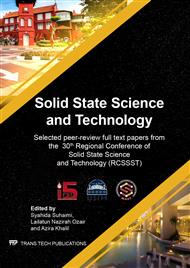[1]
M. Crabtree et al., Water Control,, Oilf. Rev. (2000) 30–38.
Google Scholar
[2]
P. Jain, V. Sharma, A. V Raju, and S. K. Patra, Polymer Gel Squeeze for Gas Shutoff, Water Shutoff and Injection Profile Improvement in Bombay High Pilot Wells in SPE Asia Pacific Oil & Gas Conference and Exhibition, 16-18 October, Brisbane, Australia. (2000) 2-5.
DOI: 10.2118/64437-ms
Google Scholar
[3]
R. Banerjee, B. Ghosh, K. Khilar, F. Boukadi, Field Application of Phenol Formaldehyde Gel in Oil Reservoir Matrix for Water Shut-off Purposes, Energy Sources, Part A Recover. Util. Environ. Eff. 30 (2008) 1779–1787.
DOI: 10.1080/15567030701268476
Google Scholar
[4]
L. T. Pham and D. G. Hatzignatiou, Rheological evaluation of a sodium silicate gel system for water management in mature, naturally-fractured oilfields, J. Pet. Sci. Eng. 38 (2016) 218–233.
DOI: 10.1016/j.petrol.2015.11.039
Google Scholar
[5]
G. A. Al-muntasheri, I. A. Hussein, H. A. Nasr-el-din, and M. B. Amin, Viscoelastic properties of a high temperature cross-linked water shut-off polymeric gel, J. Pet. Sci. Eng. 55 (2007) 56–66.
DOI: 10.1016/j.petrol.2006.04.004
Google Scholar
[6]
C. Dai, G. Zhao, Q. You, and M. Zhao, A Study on Environment-Friendly Polymer Gel for Water Shut-Off Treatments in Low-Temperature Reservoirs, J. Appl. Polym. Sci. 40154 (2014) 1–7.
DOI: 10.1002/app.40154
Google Scholar
[7]
R. E. Terry, C. Huang, D. W. Green, M. J. Michnick, and G. P. Willhite, Correlation of Gelation Times for Polymer Solutions Used as Sweep Improvement Agents, Soc. Pet. Eng. J. (1981) 229–235.
DOI: 10.2118/8419-pa
Google Scholar
[8]
R. Singh, K. Kant, and V. Mahto, Study of the Gelation and Rheological Behavior of Carboxymethyl Cellulose-Polyacrylamide Graft Copolymer Hydrogel, J. Dispers. Sci. Technol. 36 (2015) 877–884.
DOI: 10.1080/01932691.2014.930793
Google Scholar
[9]
A. D. Koohi, M. V. Seftie, A. Z. Ghalam, A. M. Moghadam, and S. Z. Sabet, Rheological characteristics of sulphonated polyacrylamide/chromium triacetate hydrogels designed for water shut-off, Iran. Polym. J. 19 (2010) 757–770.
DOI: 10.3997/2214-4609.20145990
Google Scholar
[10]
I. A. Rahman and V. Padavettan, Synthesis of Silica nanoparticles by Sol-Gel: Size-dependent properties, surface modification, and applications in silica-polymer nanocompositesa review, J. Nanomater. (2012) 2-15.
DOI: 10.1155/2012/132424
Google Scholar
[11]
F. Sun et al., Nanosilica-induced high mechanical strength of nanocomposite hydrogel for killing fluids, J. Colloid Interface Sci. 458 (2015) 45–52.
DOI: 10.1016/j.jcis.2015.07.006
Google Scholar
[12]
B. Bai, L. Li, Y. Liu, H. Liu, Z. Wang, and C. You, Preformed Particle Gel for Conformance Control: Factors Affecting Its Properties and Applications, SPE Reserv. Eval. Eng. 10 (2007) 415–422.
DOI: 10.2118/89389-pa
Google Scholar
[13]
A. Srivastava and P. Singh, Gel point prediction of metal-filled castor oil-based polyurethanes system, Polym. Adv. Technol. 13 (2002)1055–1066.
DOI: 10.1002/pat.274
Google Scholar
[14]
A. Radaic, L. R. S. Barbosa, C. Jaime, Y. L. Kapila, F. B. T. Pessine, and M. B. de Jesus, How lipid cores affect lipid nanoparticles as drug and gene delivery systems, 1st ed., vol. 24. Elsevier Inc., (2016).
DOI: 10.1016/bs.abl.2016.04.001
Google Scholar
[15]
N. Altmann and P. J. Halley, The effects of fillers on the chemorheology of highly filled epoxy resins: I. Effects on cure transitions and kinetics, Polym. Int. 52 (2003) 113–119.
DOI: 10.1002/pi.1058
Google Scholar
[16]
H. Jia, Q. Ren, Y. Ming, and X. Ping, Evaluation of polyacrylamide gels with accelerator ammonium salts for water shutoff in ultralow temperature reservoirs : Gelation performance and application recommendations, Petroleum. 2 (2016) 90–97.
DOI: 10.1016/j.petlm.2015.12.003
Google Scholar
[17]
Y. C. Ching, A. Rahman, K. Y. Ching, N. L. Sukiman, and C. H. Chuah, Preparation and characterization of polyvinyl alcohol-based composite reinforced with nanocellulose and nanosilica, BioResources. 10 (2015) 3364–3377.
DOI: 10.15376/biores.10.2.3364-3377
Google Scholar
[18]
G.A. Stahl and D.N. Schulz, Water-Soluble Polymers for Petroleum Recovery, 1st ed., Plenum Press, New York, (1988).
Google Scholar


